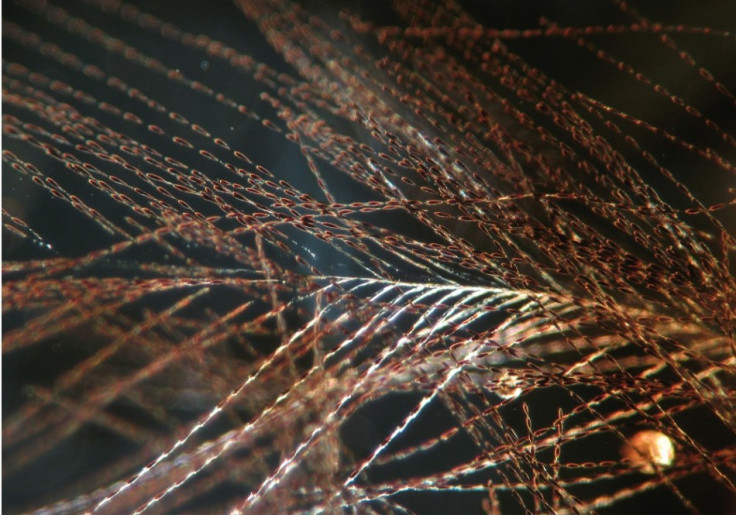Colourful Dinosaur Feathers Found In Amber Back Evolution Theories

Feather fossils from the Late Cretaceous era discovered entombed in amber in western Canada support long-held theories relating to dinosaurs, birds and evolution, scientists say.
The 11 fragments show the progression from hairlike "filaments" to the doubly-branched feathers of modern birds, providing a new insight into the structure, function and colour of animals that were living some 80 million years ago, an article in the journal Science explains.
The discovery and analysis was led by researchers from the University of Alberta, and according to palaeontologist Ryan McKellar, the specimens represent distinct stages of feather evolution, and corroborate the idea that many dinosaurs sported feathers which were sometimes brightly coloured.
Close analysis of the fragments also indicates that the feathered creatures may also have had a range of transparent, mottled, and diffused colours, resembling birds today.
While researchers are still trying to find out which feathers belonged to birds or dinosaurs, they did find that filament structures they observed are similar to those seen in other non-avian dinosaur fossils.
Recent years have been marked by a renewed interest about the origins of feathers as we know them now in birds. The new discovery supports a model for the evolution of feathers that has previously relied on compression fossils, which were found in China and bore outlines of primitive "filament" feathers that are more akin to hair.
Moreover, the amber-entombed feathers show that some of the most primitive feather types, also known as protofeathers, were still around before the dinosaurs went extinct.
"We're finding two ends of the evolutionary development that had been proposed for feathers trapped in the same amber deposit," said McKellar.
The research also confirms that the filaments progressed to tufts of filaments from a single origin, called barbs, which can in later development coalesce into a central branch called a rachis and as the structure develops further, more branches of filaments form from the rachis.
"We've got feathers that look to be little filamentous hairlike feathers, we've got the same filaments bound together in clumps, and then we've got a series that are for all intents and purposes identical to modern feathers," McKellar told BBC News.
"We're catching some that look to be dinosaur feathers and another set that are pretty much dead ringers for modern birds."
By the Late Cretaceous period, feathers had more or less reached the end of their evolution, so the team was fortunate that specimens bearing such a wide range of different feather types happened to be trapped in the same amber deposit.
"We've known for quite a while that several of the non-bird dinosaurs actually had feathers and many of them had feathers that are identical to the feathers you see on a pigeon in the park today," said Mark Norell, chairman of the palaeontology division at the American Museum of Natural History in New York.
"What's interesting is the diversity of feathers that were present in non-avian dinosaurs that existed pretty close to that time interval when those animals disappeared around 65 million years ago," he told the BBC.
According to the team, none of the feathers was adapted for flight, but the latest feathers show adaptations for swimming
A second article in Science examines the feathers' colour and demonstrates feathers are given their colour by structures in their cells called melanosomes, which contain melanin, the chemical that gives us our skin colour.
The problem, however, is that in most cases the melanosomes of feathers are slowly destroyed with time, making it difficult to know what colour a given dinosaur would have been.
The new findings suggest that one of the first feathered dinosaurs ever discovered, the Sinosauropteryx, was a "redhead".
"A perfect understanding of colour is unlikely except in perhaps exceptional cases," Roy Wogelius of the University of Manchester said in an online chat about the work in July, the BBC reported. "But with the technological advances we are optimistic that we will be able to find chemical details beyond simply dark and light patterning."
"If you were to transport yourself back 80 million years to western North America and walk around the forest... so many of the animals would have been feathered," said Norell.
"We're getting more and more evidence... that these animals were also brightly coloured, just like birds are today."
© Copyright IBTimes 2025. All rights reserved.





















